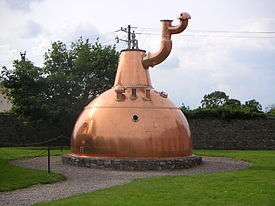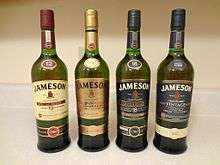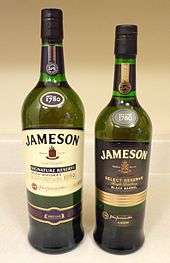Jameson Irish Whiskey
 | |
| Type | Irish Whiskey |
|---|---|
| Manufacturer | Irish Distillers (Pernod Ricard) |
| Country of origin | Cork (originally Dublin), Ireland |
| Introduced | 1780 |
| Proof (US) | 80 |
| Variants | Crested Ten, 12 Year Old, 18 Year Old, Gold |
| Related products | Paddy, Powers, Tullamore Dew |
Jameson is a blended Irish whiskey produced by the Irish Distillers subsidiary of Pernod Ricard.
The John Jameson and Son Irish Whiskey company was formally established in 1810 when John Jameson and his son (also John Jameson) took ownership of the Bow Street Distillery in Dublin which had originally been built by his wife's cousins the Steins in 1780. Jameson was a Scottish lawyer from Alloa in Clackmannanshire who had married Margaret Haig, a sister of the Haig brothers who owned the Haig distilleries. Margaret Haig was a first cousin of the Steins, a Scottish distilling family, also from Clackmannanshire, with significant distilling interests in Scotland and Dublin. On his marriage to Margaret Haig in 1786, John Jameson moved with his new wife to Dublin to manage the Stein's Bow Street Distillery (which had been established in 1780) for Margaret's Stein uncle. This explains the use of the year 1780 in Jameson marketing as the Bow Street Distillery was where Jameson Irish Whiskey was born.[1] Portraits of John and Margaret Jameson by Sir Henry Raeburn are in the collection of the National Gallery of Ireland.
Originally one of the six main Dublin Whiskeys, Jameson is now distilled in Cork. In 2013, annual sales topped 4.7 million cases (56.4 million bottles). Jameson is by far the best selling Irish whiskey in the world, as it has been sold internationally since the early 19th century. The United States is the largest market for Jameson Whiskey, with consumption during 2013 up by 12%.[2]
Company history
When John Jameson, a Scottish businessman,[3] became manager of the Stein family Bow Street Distillery in 1786, it was producing about 30,000 gallons annually. By the turn of the 19th century, it was the second largest producer in Ireland and one of the largest in the world, producing 1,000,000 gallons annually. Dublin at the time was the centre of world whiskey production. It was the second most popular spirit in the world after rum and internationally Jameson had by 1805 become the world's number one whiskey. Today, Jameson is the world's third largest single-distillery whiskey.
Historical events, for a time, set the company back. The temperance movement in Ireland had an enormous impact domestically but the two key events that affected Jameson were the Irish War of Independence and subsequent trade war with the British which denied Jameson the export markets of the Commonwealth, and shortly thereafter, the introduction of prohibition in the United States. While Scottish brands could easily slip across the Canada–US border, Jameson was excluded from its biggest market for many years.[4]

The introduction of column stills by the Scottish blenders in the mid-19th-century enabled increased production that the Irish, still making labour-intensive single pot still whiskey, could not compete with. There was a legal enquiry somewhere in 1908 to deal with the trade definition of whiskey. The Scottish producers won within some jurisdictions, and blends became recognised in the law of that jurisdiction as whiskey. The Irish in general, and Jameson in particular, continued with the traditional pot still production process for many years.
In 1966 John Jameson merged with Cork Distillers and John Powers to form the Irish Distillers Group. In 1976, the Dublin whiskey distilleries of Jameson in Bow Street and in John's Lane were closed following the opening of a New Midleton Distillery by Irish Distillers outside Cork. The Midleton Distillery now produces much of the Irish whiskey sold in Ireland under the Jameson, Midleton, Powers, Redbreast, Spot and Paddy labels. The new facility adjoins the Old Midleton Distillery, the original home of the Paddy label, which is now home to the Jameson Experience Visitor Centre and the Irish Whiskey Academy. The Jameson brand was acquired by the French drinks conglomerate Pernod Ricard in 1988, when it bought Irish Distillers. The old Jameson Distillery in Bow Street near Smithfield in Dublin now serves as a museum which offers tours and tastings.[5][6]
In 2008, The Local, an Irish pub in Minneapolis, sold 671 cases of Jameson (22 bottles a day),[7] making it the largest server of Jameson's in the world – a title it maintained for four consecutive years.[8]
Varieties


As well as Jameson Original, the Jameson Reserves include:
- Jameson 12 Year Old Special Reserve (Formerly known as Jameson 1780)
- Jameson 12 Year Old Distillery Reserve is available at their two visitor centres in Ireland and also available from their online shop.[9]
- Jameson Gold Reserve (the only expression of Jameson that uses virgin American oak).
- Jameson 18 Year Old Limited Reserve
- Jameson Rarest Vintage Reserve (Jameson's oldest and rarest whiskey components).
- Jameson Signature Reserve (exclusive to travel retail and duty-free shops around the world).
- Jameson Select Reserve Black Barrel (available in limited quantities in the US; known as "Small Batch" outside the US).[10]
- Jameson Caskmates (finished in stout-seasoned barrels)[11]
Production process
Jameson is produced from a blend of grain whiskey, single malt whiskey and single pot still whiskey, which uses a mixture of malted and unmalted or "green" Irish barley, all sourced from within a fifty-mile radius around the distillery in Cork. The barley is dried in a closed kiln fired by natural gas (formerly anthracite coal). This is in contrast to the traditional method used in some Scotch whisky distilleries, which fire the kiln with peat, adding a distinctive peat flavour.[12]
Awards
Jameson products – in particular its 18-Year and its Rarest Reserve – have rated very highly at international spirit ratings competitions. The 18-Year received a series of gold and double gold medals at the San Francisco World Spirits Competition between 2005 and 2010.[13] The Rarest Reserve has won gold and double gold medals there as well. Rarest Reserve is rated as one of the Top 20 whiskies in the world by Proof66.[14]
Personal
John Jameson is also the great grandfather of inventor Guglielmo Marconi.[15]
See also
- Irish whiskey brands
- Scotch whisky
-
 Liquor portal
Liquor portal
References
- ↑ McNamara, Stuart. "Haig Whisky & Jameson – History of the Whisky Cousins". HaigWhisky.com. Retrieved 11 July 2015.
- ↑ "Jameson Experience, Midleton". Retrieved 5 September 2014.
- ↑ https://web.archive.org/web/20090320165717/http://www.jamesonwhiskey.com/Home.aspx. Archived from the original on 20 March 2009. Retrieved 18 March 2009. Missing or empty
|title=(help) - ↑ Dias Blue, Anthony (2010). The Complete Book of Spirits: A Guide to Their History, Production, and Enjoyment. HarperCollins. p. 165. ISBN 9780062012814.
- ↑ "Welcome to the Home of Jameson Whiskey". Retrieved 2014-05-12.
- ↑ "Ireland Whiskey Trail". Ireland Whiskey Trail. Retrieved 14 May 2014.
- ↑ Kimball, Joe. ""Minneapolis bar wins Irish whiskey sales award", Mar 9 2009". Minnpost.com. Retrieved 2013-10-29.
- ↑ Leon, Michelle (2010-05-14). ""Jameson at the Local: Drink of the week," May 14, 2010". Blogs.citypages.com. Retrieved 2013-10-29.
- ↑ "Jameson Vistior Centre". Retrieved 6 June 2012.
- ↑ "Jameson Black Barrel Select Reserve". IrishWhiskey.com. Retrieved 12 July 2015.
- ↑ "Jameson Caskmates". Jameson Irish Whiskey. Retrieved 4 August 2016.
- ↑ Stuart, McNamara. "A Beginners Guide to How Irish Whiskey is Made.". IrishWhiskey.com. Retrieved 12 July 2015.
- ↑ "Summary Page for Jameson 18-Year". Proof66.com. Retrieved 2013-10-29.
- ↑ "Top 20 Whiskies at". Proof66.com. Retrieved 2013-10-29.
- ↑ Marconi: the Irish connection, Michael Sexton, Four Courts Press, 2005
External links
Coordinates: 53°20′54.15″N 6°16′35.61″W / 53.3483750°N 6.2765583°W